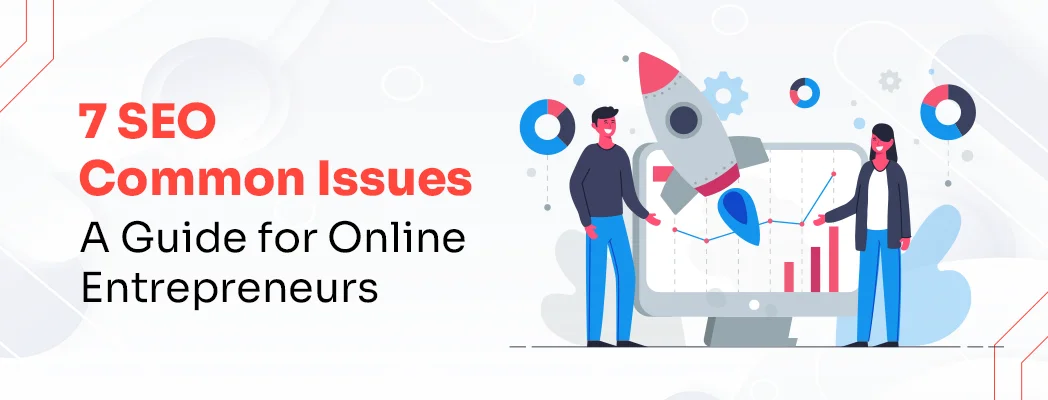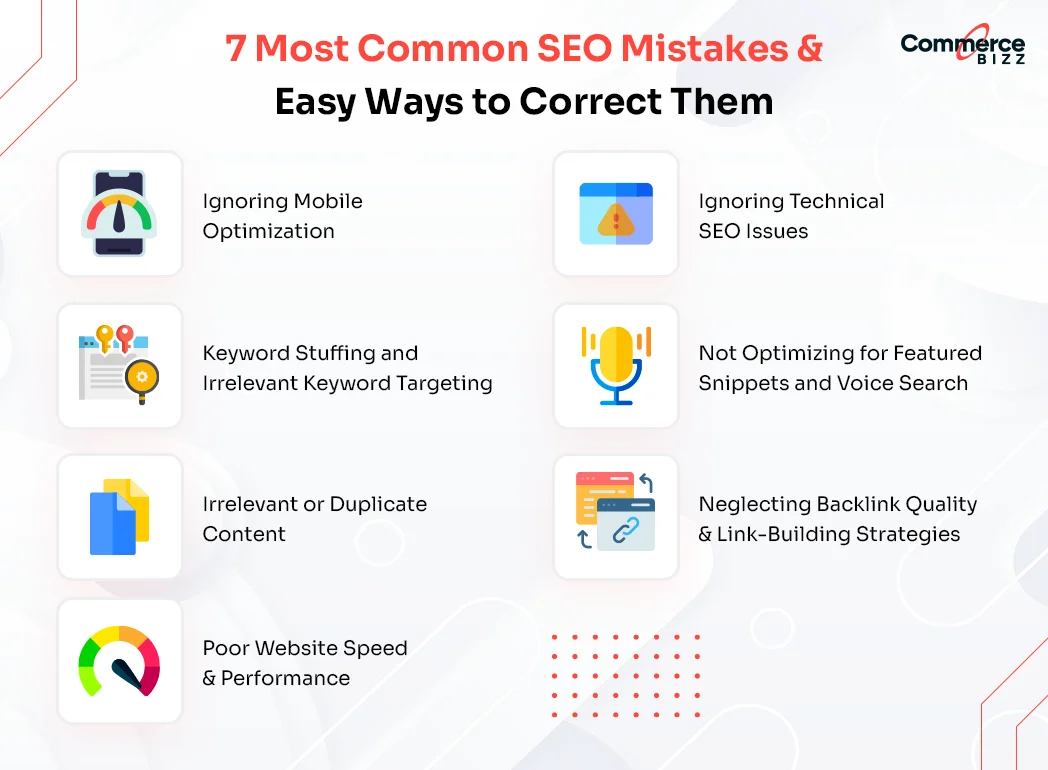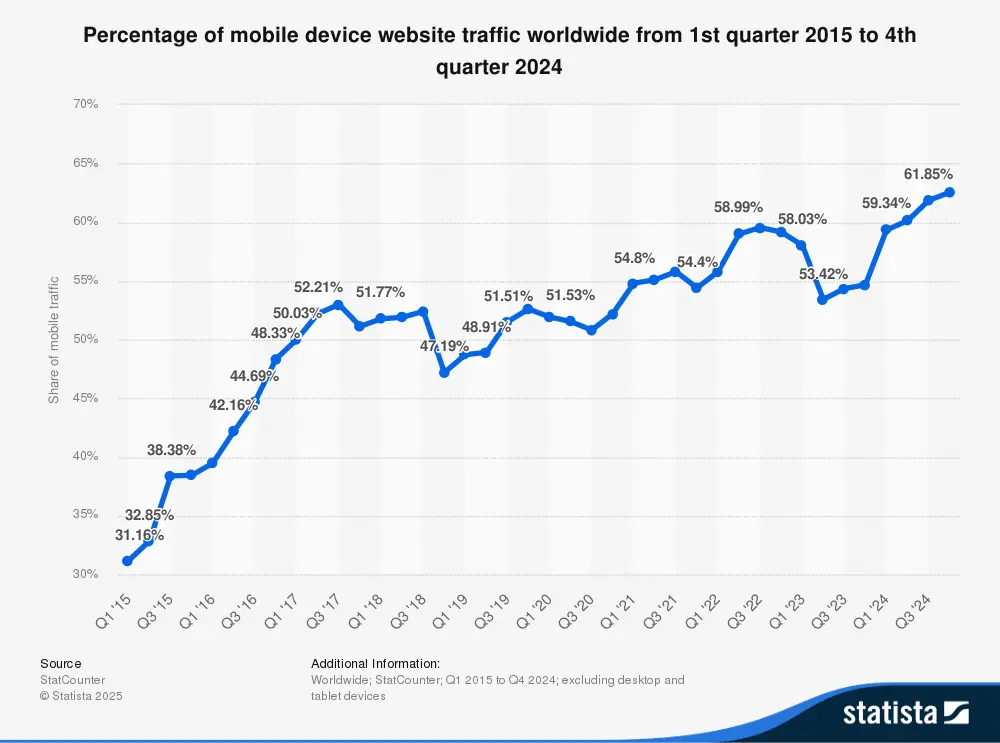
Imagine pouring in hours of hard work into building a website, only to realize no one is able to find it. Sounds frustrating, right? This happens when you let the biggest SEO mistakes fly under the radar.
As an online business owner or digital marketer, you know how important it is to rank on Google. This is what makes your business a success or breaks it entirely. But, small and seemingly harmless mistakes like slow speed or poor keyword usage can bury your site deep inside the search results.
What seems like a simple and minor mistake can cost you your customers and sales! The good news, though, is that you can fix these common SEO mistakes in digital production easily. We have uncovered the top 7 common SEO mistakes that eCommerce owners or digital marketers make. Read through this guide and you will learn why you need to fix them immediately and how.
Why SEO is Crucial for Online Businesses
For eCommerce businesses, SEO is no longer an option to choose, it is a necessity. Imagine having the best products on your store but, still people aren’t receiving the information. What is happening here?
Your target is likely to turn to Google to find products you are selling. If they don’t receive your website in response, you may not be able to reach them.
SEO is what will help you reach your target market on the search results, especially to people actively looking for you. It is a means to drive organic traffic and can help you find a relevant audience without investing a lot in ads.
With SEO, you can save a lot of money, drive more traffic, and increase your sales. This directly helps you maximize your revenue and generate repeat visits that accelerate business growth.
- With the right strategies, you can help people find your website naturally without relying on paid ads.
- SEO strategies can help build user's trust on your brand and further their trust in you.
- It helps improve clicks, leads and sales for the business.
However, the SEO algorithms keep evolving, which requires you to stay updated with them. An overnight update can shake the rankings or reward your website for following all the right practices. That's exactly why you should invest in good SEO. It is a continuously evolving strategy, where you need to audit the strategies and keep improving them.
7 Common SEO Mistakes and How to Fix Them
Even small search engine optimization issues can have a major impact on your website’s ranking and traffic. You will notice that these mistakes hold back your business from growing.

Here, we will break down the common SEO mistakes that most eCommerce owners and digital marketers make and how you can fix them.
Mistake 1: Ignoring Mobile Optimization
Did you know that approximately 60% of the global web traffic comes from mobile devices? Now, imagine you don’t have a mobile-friendly website! How frustrated would your users be when they try searching for you?

You would end up hurting your search rankings and sales beyond recovery with such eCommerce mistakes.
You cannot ignore mobile optimization for your eCommerce website as Google conducts mobile-first indexing. This means, the search engine crawls and ranks your mobile site before visiting the other versions.
When you don’t have a mobile-first website, you will notice fewer visitors and a lot of lost opportunities. Using a responsive design, you can ensure your website adapts to any device and offers a consistent user experience.
When you create mobile-friendly content, you make it readable. It will also include fast-loading images and simple navigation that impacts engagement.
Steps to Test and Mobile Performance Optimization
- Begin by testing your site using the mobile-friendly test by Google.
- You should compress the images and minimize coding that can enhance page speed.
- Use the responsive design to ensure the site can adjust to all screen sizes.
- Simplify your navigation using clear menus and clickable buttons.
Mistake 2: Ignoring Technical SEO Issues
Even with the best content and strong keywords, your traffic and rankings could take a hit. This could be because you didn’t consider technical search engine optimization issues.
Technical SEO is what helps the search engine understand the site properly and crawl through it without missing a single element. You will be able to gain maximum visibility when you don’t ignore technical optimization.
So, what is technical SEO? It is all about optimizing the backend to help search engines like Google navigate through the website and rank it. If there are technical errors, you might notice that the search engines struggle through it, which lowers the rankings.
- Broken or dead links are some of the common SEO mistakes in digital content production. It can break the customers movement on the website and disrupt the search engine’s crawling.
- When you repeat content across the website, you might notice diluted rankings for the business.
- Missing or outdated sitemap can also prevent the crawlers from indexing your website properly.
Steps to Fix Technical Issues
- You must run a thorough SEO audit on the tools like Google Search Console or Screaming Frog. This would help identify the mistakes or issues your website is facing.
- Start by fixing all the broken links from the audit using 301 redirects. You can also update the outdated links.
- Use canonical tags to eliminate duplicate content and ensure your site contains unique content.
- Optimize the sitemap for your website and submit it to Google to improve indexing.
Mistake 3: Keyword Stuffing and Irrelevant Keyword Targeting
Have you ever come across a piece of content on a website that has forced the same keyword across sentences? That is what keyword stuffing feels like. The old Google algorithm appreciated keyword cramming, allowing your websites to rank higher on the search engine.
However, things have changed and so has the algorithm. Today, Google penalizes anyone who has overloaded the content with the same keyword. In fact, if the keyword appears unnaturally, you might hurt your website's ranking or user experience.
Keyword stuffing can sound a lot spammy and unnatural. Most people who are reading such content may not like it either. As a result, you would notice poor readability and higher bounce rates with such content. Moreover, this can trigger penalties from Google, thus reducing your rankings.
That’s where keyword research and intent-based targeting comes to help. It is no longer about using maximum keywords; it is about using the right keywords. You must research for high-value and intent-based keywords that ensure your content aligns with what people are researching for.
You can use a mix of transactional and information keywords. They would help attract the users and convert the ready-to-buy ones.
Best Practices to Implement Keywords Naturally
- You must use keywords naturally in the titles, headers and across the content on the page.
- Focus on your user’s intent while planning keywords and their placements to ensure your page answers the real questions.
- Use synonyms or related terms that can enhance relevance and avoid repetition.
- You must create human-first content. Make sure you write for the humans and not the search engines.
When you create well-optimized pages where keywords appear naturally and serve the reader’s needs, you might improve engagement and improve conversions.
Mistake 4: Not Optimizing for Featured Snippets and Voice Search
Did you know that about 20.5% of the online searches are voice-based?
Users tend to ask full questions on the new-age voice assistants like Alexa and Siri on the best SEO strategy. It has become important for your business to optimize the content for these voice-based searches.
If your content is not produced on voice demand, you may lose potential conversion opportunities and traffic. The other popular SEO strategy includes featured snippets. You would be making one of the biggest SEO mistakes if you hadn’t created these snippets as your prime real estate for search engines.
Here are a few steps on how to create featured snippets for your blog post or other content formats.
- Use question-based headings to create these snippets. For example, answering a question like How to improve SEO rankings could be a good case for snippets.
- Answer with short, clear and direct responses. Your response should be about 40 to 60 words.
- You should structure the content with lists, tablets and bullet points to ensure it gains maximum ranking on the search engine.
Actionable Tips to Create Snippets
- You should target long-tail keywords that can mirror natural speech patterns to enable it for voice searches as well.
- Optimize the content to ensure it ranks on “People Also Ask” that appears on the search results.
- You can use structured data like Schema markup to ensure the search engines understand your content better.
- Make sure to improve the page speed and mobile-friendliness so that the users get the same results when searching online.
Mistake 5: Irrelevant or Duplicate Content
When you create content for search engines, you must think about quality before quantity. Let’s break this down for you a bit. For instance, if your site contains a lot of duplicate content, search engines might flag it.
The same goes for superficial and irrelevant content that doesn’t come across as valuable to search engines and users. This can reduce your ranking and lower your credibility as well.
Google can help prioritize the helpful and original content for the users, moreover, it takes a people-first content ranking strategy, which helps rank the content that is most valuable to them.
So, you can no longer rank with a content strategy that depends on keyword stuffing or adding fluff.
Let's take a look at how thin or duplicate content impacts website rankings.
- It can lower the rankings and devalue your pages. Moreover, if the website page contains duplicate content, search engines ignore them.
- Search engines may waste a lot of time crawling the redundant pages, while not indexing the valuable ones. This can also impact the rankings.
- It can also lead to poor user experience, in case your content lacks depth. This can also increase bounce rates and lower reputation.
Here are some quick and effective strategies to overcome the content-related search engine optimization issues.
- You must begin writing your content for the audience and not for the search engines that crawl. For this purpose, you must identify topics that can solve real issues they face.
- You can use original and expert data plus insights to stand out from the competition with your content.
- Make sure to avoid using duplicate content from other pages or even internal ones that can harm website rankings.
- You should create comprehensive content that can answer a single query. Using superficial content may not solve their problem.
Keeping the content fresh and up-to-date makes a lot of sense at this point, especially as industries keep changing fast. You must keep updating the older posts and repurpose the content to match new-age formats.
It is a good idea to audit the content to ensure you can remove unwanted content and focus on delivering value via your website.
Mistake 6: Neglecting Backlink Quality and Link-Building Strategies
When it comes to common SEO mistakes in digital content production, you cannot ignore neglecting backlink quality. Backlinks are considered to be the biggest factors for ranking on search engines. However, not all the links you use may seem equal.
In some cases, the links may be low-quality or spammy. This can harm your content rather than doing good. If you don’t prioritize high-quality or authoritative backlinks, you might miss out on opportunities to boost search rankings or credibility.
Let's look at why backlink quality matters to your business.
- It can help improve the domain’s authority. When you add links from reputable sites to the content, your content automatically becomes trustworthy.
- When you use a backlink from a popular website, you can send targeted visitors to the page. This referral traffic can ensure you can gain more visitors.
- Quality backlinks can also help boost rankings by understanding the relevance and value your site offers.
Here are some common link-building mistakes you should avoid
- Avoid buying backlinks as Google can penalize your business for using unnatural or paid links.
- By using spammy directories, you can incorporate low-quality links that hurt your site’s reputation.
- When you focus on quantity over quality, you can hurt the reputation. While there are a lot of links in your content, they don’t deliver the quality.
Here are the best practices to deliver authoritative backlinks in the content
- You must create shareable and high-value content that can attract quality backlinks.
- Create guest posts on relevant and high-authority websites in your niche to attract backlinks.
- You can use digital PR and reach out to journalists or bloggers to gain mentions. That is also a way to generate quality backlinks.
- Monitor and remove the toxic links before the Google search console goes out to penalize your website.
Make sure you create a link-building strategy that helps in improving your reputation and authority.
Mistake 7: Poor Website Speed and Performance
How does the poor loading speed impact your site’s conversion rate? According to a report, the bounce rate increases by 32% as the loading speed goes from 1 to 3 second. A slow site would not just frustrate the visitors, it can also ruin your SEO rankings completely. There are fewer chances of people actually stopping on the site and engaging with it, taking away your conversion opportunities with it.
Fast-loading sites are a must if you want to rank high on Google. Sluggish sites don’t reach the radar of search engine rankings.
Let's look at how a slow-loading page can hurt SEO or user experience.
- If your site loads slowly, people will leave even before it completes making an appearance. As a result, you will notice an increase in bounce rates.
- Google's algorithm favors websites that showcase fast loading speeds. With a slow and unoptimized site, you may not be on Google's radar.
- A slow site means your user will not wait for you to load. As a result, they may not make purchases on your site, lowering your sales.
If your website is too big and unoptimized, it might take a lot of time to load. This is one of the commonly seen factors that cause website speed issues. Additionally, if you have been facing too many HTTP requests from ads and third-party elements, it can hamper the speed.
Lastly, if your browser is not cached properly, you will notice issues when reloading the elements. This can also hurt the site’s speed.
Practical Fixes to Enhance Loading Speed
- You must compress the large format images with tools like TinyPNG or WebP formats.
- Enable caching on your browser to store the files or data that are frequently used.
- You can minimize the HTTP requests to reduce the unnecessary plugins and scripts.
- Use a content delivery network that can help distribute content across multiple servers, thus improving load times.
SEO Best Practices to Stay Ahead
Remember, SEO is not something you do once and forget about it. It is a continuous process, where you need to ensure regular monitoring and strategic improvements. It is crucial to practice a few best practices to stay ahead of the curve.
SEO Performance Monitoring and Regular Audits
You must conduct SEO audits regularly to avoid common eCommerce mistakes for optimization. These audits will help understand the technical issues, identify the keyword opportunities and determine the performance gaps.
You can use tools like Google Search Console and Ahrefs to fix broken links, ensure the right indexing and track the rankings. You should stay proactive to prevent these small issues so that they don't turn into ranking disasters.
Staying Updated with Google’s Algorithm Changes
Google continuously updates its ranking algorithms. These algorithms can impact the rankings of the website. You must follow the search central blog and other reputable sources to ensure your SEO strategies adapt to the new algorithms before you hurt rankings.
Investing in Content Marketing and User Experience (UX)
You must create high-quality and user-centric content to ensure the proper search engine optimization. You must create valuable and engaging content that addresses the search intent of the users. You must ensure a seamless user experience with fast-loading pages and intuitive navigation while designing the solutions.
Leveraging AI and Automation for SEO Success
By implementing AI and automation in SEO, you can optimize the content and analyze the search intent to deliver the relevant content. You can use tools that can automate services like keyword tracking, backlink analysis and reporting to scale SEO effortlessly.
Conclusion
SEO has been a game changer for eCommerce websites. However, common SEO mistakes in digital content production, such as poor links and neglect of technical SEO can hamper your website growth and profitability.
From slow loading to outdated keyword strategies, there are several mistakes that put you off Google's radar forever. You can change this by focusing on high-quality content, fast performance and effective SEO strategies. The idea is to optimize your site for visibility and attract more customers that translate into sales.
CommerceBizz will offer you custom eCommerce development services that are SEO-friendly. We help you build, optimize and grow your online store to success. So, if you want to level up your eCommerce game, come and partner with our team.
Frequently Asked Questions
#1. What are the most common SEO mistakes?
The most common SEO mistakes you are likely to make include ignoring mobile optimization, stuffing keywords into the content and slow site speed.
#2. How can I fix SEO errors on my website?
You must conduct regular audits with tools like Google Search Console to fix your broken links and optimize website speed.
#3. Why is my website not ranking on Google?
The possible reasons for not being able to rank on Google include poor keyword targeting and slow loading speed. You may also see a lowered site speed because of technical issues and a lack of backlinks.
#4. What causes a drop in website traffic?
You may notice a drop in website traffic because of the Google algorithm updates, lost backlinks, and outdated content on the page.
#5. How to improve SEO for my online business?
You must focus on creating high-quality content that can be optimized for mobile and build authoritative links if you want to enhance your SEO and improve website traffic.
#6. How can I check if my website is mobile-friendly?
You can use a mobile-friendly test provided by Google or you can inspect the site on different devices. These methods can help you check if your site is mobile-friendly.
#7. What are featured snippets, and how can I optimize for them?
Featured snippets are what appear as summaries at the top of the search results on the Google search engine. You can provide clear and structured answers or respond using FAQ-style content in this format.
#8. What are the best tools for SEO analysis?
Google Search Console, Ahrefs, SEMRush and Google Analytics are some of the top tools that help track SEO performance.

